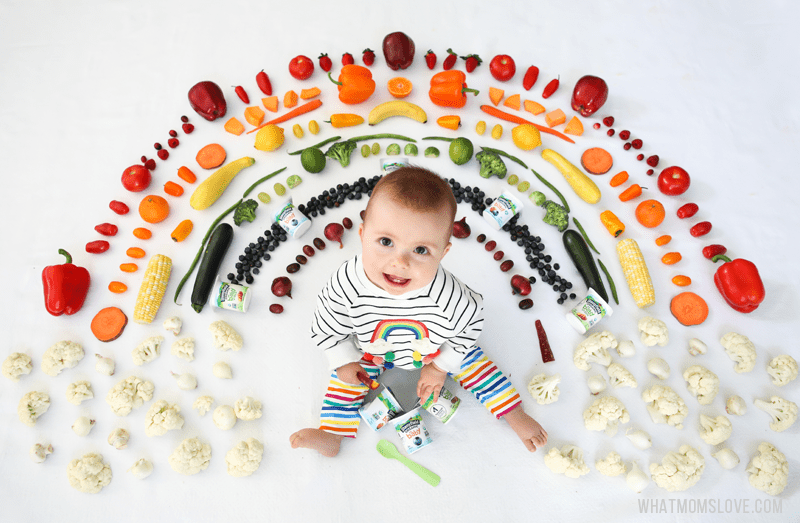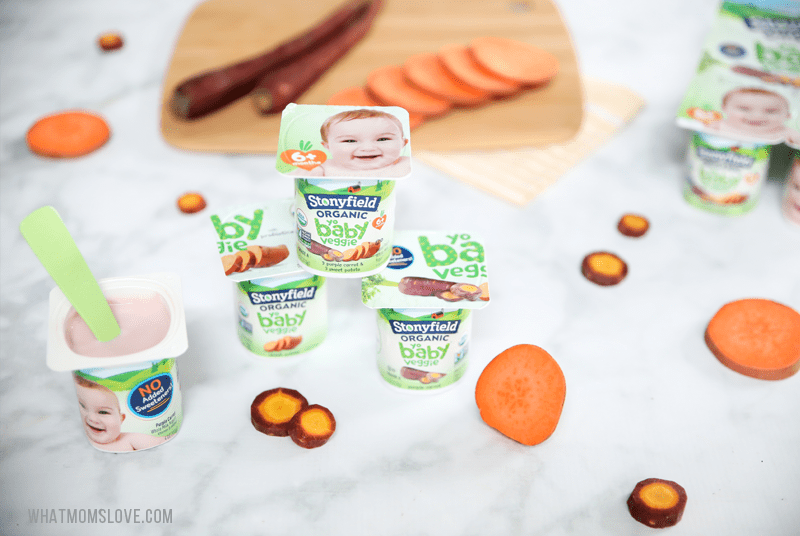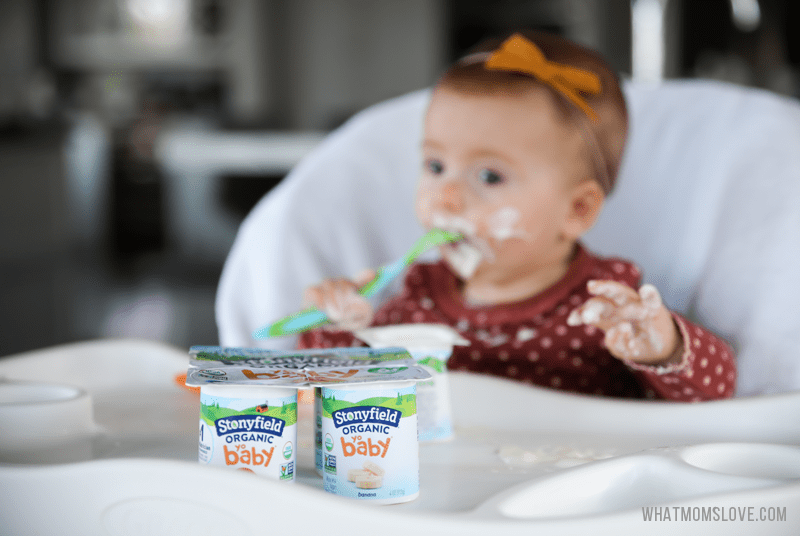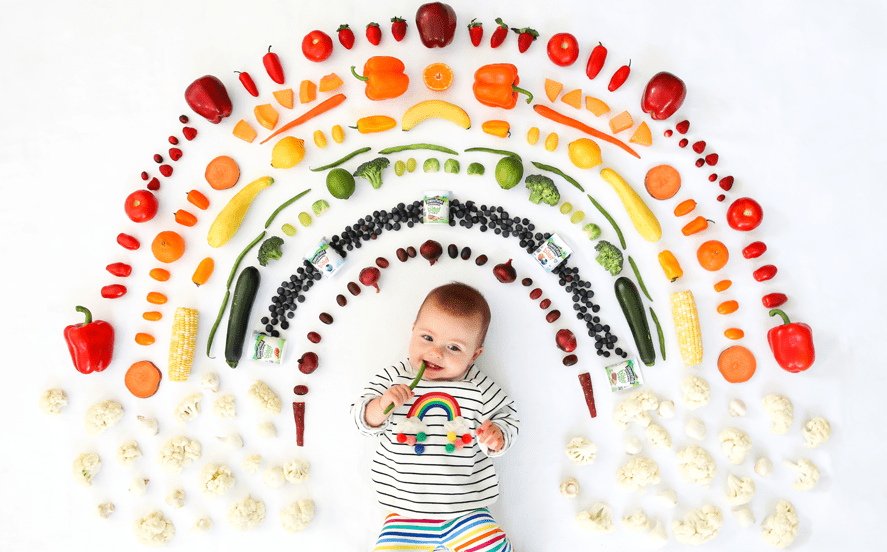Wondering if there’s a way to prevent your kids from becoming picky eaters? Or how to get a fussy eater to actually eat and try new foods? We’re here to help with tips you can immediately put into action – and perhaps even prevent picky eating all together.
No parent wants their child to be a picky eater. The thought of feeding them the same 3 things day after day, cooking them separate meals, and battling through breakfast, lunch and dinner for YEARS is nothing any parent would ever wish upon themselves.
Yet almost 50% of parents would label their toddlers as a picky eater – one who would rather give away their entire collection of Super Hero figures than take a tiny bite of anything green.
But there is good news: studies have shown that there are ways to stay ahead, and perhaps even prevent picky eating in your baby or young toddler.
And with the help of our sponsor, Stonyfield Farm, we’re here to provide you with 18 helpful strategies to set you and your children up for adventurous eating success.
So whether you’re cooking chili or chicken fingers, your kids will greet their meals with the same response: Mmmmm!
Note: this post may contain affiliate links. For more information, please see our disclosure policy.
PIN for when you’re ready to raise a not-so-picky eater!

TIPS FOR BABY’S FIRST FOODS
EXPOSE YOUR BABY TO DIFFERENT FLAVORS, RIGHT FROM THE START
Research has shown that the earlier you introduce your child to a food, the more likely they will like it and continue to eat it throughout their lifetime. So if you’re just starting your food journey with your infant, it’s crucial to expose them to as many different flavors as possible – so bring on those green beans and carrots, early and often.
Once your child is ready, and with the guidance of your pediatrician, introduce them to a rainbow of fruits and vegetables. Don’t just stop at peas and beans – think cabbage, collards and kale.

Add in proteins and grains and don’t be afraid to experiment with a variety of herbs and spices. Even if it’s something you don’t particularly like, that doesn’t mean your child has to feel the same!
You can even introduce your baby to yogurt beginning at 6 months which can open the door to them trying a slew of new flavors. We recommend starting with ones with no added sweeteners, like the New Stonyfield Farm YoBaby Veggie which is made with Purple Carrots and Sweet Potatoes (their Plain and Banana Mango flavors also have no added sweeteners), and are made with only Certified Organic ingredients. This means no artificial flavors or preservations, toxic persistent pesticides, antibiotics, artificial growth hormones, or GMOs – things you don’t want to worry about, especially in a first food.

Every new taste will ultimately help them develop a broader palate and make them more willing to try other foods.
VARY TEXTURE & SIZE
In addition to exposing your young child to a variety of different flavor profiles, it will also benefit them to experience different textures. Transition from smooth textures, like purees and yogurt, to chunkier stews and soft solid foods. This will not only help them learn that not all foods feel the same in their mouth, but also teach them how to use different muscles to chew and swallow.
Also vary how your child sees their food – from small bite-sized pieces that can be picked up with thumb and finger, to larger sticks that can be held in a fist. They’ll get comfortable with the notion that food comes in all shapes and sizes.
LET THEM GET MESSY
Grab a great bib (we love this one with sleeves) and a splat mat, and let your baby feel that food! Babies explore the world through their hands and mouths (which is why they put everything in it), so let them explore the food they are eating with both.
If your baby is grabbing for the spoon out of your hand, let them have it! Load it with a scoop and you’ll be surprised how quickly they learn how to get it in their mouths. Or forget the spoon and have them use their fingers. At this age, having them form a good relationship with the food is much more important than any “manners”.

We love the thickness of the Stonyfield Organic YoBaby Yogurts – it makes it easy for baby to eat and explore a delicious smooth texture all by themselves. And it’s the #1 Pediatrician recommended yogurt!
IF AT FIRST YOU DON’T SUCCEED…
Yep, just like the saying goes, it will eventually pay off to “try, try again”. If your child doesn’t show an interest in a food on the first try (or downright rejects it with a look of disgust!), it is completely normal, and doesn’t mean that they will never like it.
Studies show that it can take anywhere between 10-20 times of your child just seeing a food before they will try it, so keep at it. It can be completely frustrating to keep serving a food (that takes your time and money to put on the table) that is constantly rejected, but your persistence can pay off in a big way. And now is the time to keep at it because as your child ages, the number of times they need to try the food before accepting it gets exponentially higher.
MODEL HEALTHY HABITS
Even at a very young age, babies are always watching and will copy your behavior. If they see you eating colorful, healthy foods, they will be more likely to try them as well.
Sit down with them at the table (or pull up their highchair to where you’re eating) to include them in family mealtime. Engage in conversation – even if they can’t talk back! It’s a great opportunity to talk to them about what they’re eating and teach them about color, texture and how the food helps fuel their body. Learning how to be social at mealtime will ultimately help them enjoy sitting down and eating in the future.
RESPECT THEIR LIMITS
This may go without saying, but once your child gives signs that they are done with their food – whether they ate one bite, or one hundred – they are done.
Babies will often give signs of not opening their mouths or pushing a spoon away, so don’t try and give them a few more bites just because you feel they haven’t eaten enough, or because there’s still food left in a container. Respect that they have decided that their body is full.
This ability to read your child’s feeding cues can help them learn appetite regulation and healthy, mindful eating.
As your child moves into toddlerhood, giving them the power to decide when they are finished becomes infinitely more difficult. We’ll discuss some tips to follow as your child ages in the next section.
TIPS FOR TODDLERHOOD + BEYOND
As your child moves into their first year, their willingness to try new foods often starts to decrease, and this is usually when the real food struggles start to form. Rest assured that most kids will come out of this phase by the time they enter the 3-5 age range, BUT that is only if the picky eating has been handled correctly.
The strategies below can help set a strong foundation for the picky toddler years, so you can come out the other side relatively unscathed.
MAKE ONE MEAL
The idea of making just one meal for your family that everyone eats – adults and kids – sounds pretty easy, right? But we know from experience with our own picky eaters, that it is all too easy to fall into the trap of making your child their favorite foods that you know they’ll eat quickly, and without complaining, whining or worse.
Unfortunately, when you start making every child their personal “easy” meal foods, you quickly become a short order cook, and they don’t get the variety they need. Of course it helps to consider your child’s tastes when planning a family meal, but that doesn’t mean you have to eat chicken fingers and pizza for dinner every night. If they like pasta and cheese, try a pasta casserole with other proteins and veggies mixed in. Even if they pick through it for the parts they’re comfortable with, they are still exposed to the other ingredients, and with each new exposure they will become more accepting of the dish as a whole.
Editor’s note: The Make One Meal “rule” can be adapted to what works best for your family. For mine, I’m OK with making my kids their choice for breakfast (as long as it includes a healthy side of fruit) because it’s usually quick and easy; but for dinners, it’s what’s served on the table or nothing.
NO BRIBES OR CLEAN PLATE CLUBS
We think this strategy is probably the hardest one of them all. It is so, so tempting to tell your toddler “eat 5 more bites then you can have XYZ” (XYZ being something much higher on their delicious scale than green beans), or “you have to clean your plate, then you can have dessert”, because it actually can be fairly effective. The only problem is that you are essentially saying to your child that the food on their plate is yucky and the only way they can get through eating it is by having something far more yummy at the end.
Furthermore, making deals with your child to eat can ultimately create a negative relationship with food and alter their ability to self-regulate their appetite.
If your child says they’re full, then you have to respect that. If they really haven’t eaten a lot, keep their meal and let them know that if they are hungry later, that will be what is available to them.
Think of it as your job to provide healthy food that will help nourish your child’s body. It is their job to decide if they want to eat it or not.
GIVE THEM CHOICES
Providing your child with choices can make them feel more in control of the situation, ultimately allowing them to be more open to eating and trying new things.
Try serving food family style and letting them decide how much to portion.
Kids love a good theme, so bring on the “Taco Tuesday” or “Rice Bowl Thursday” where you set up all the ingredients and have them build their own meal.
Offer 2-3 veggies and let your child pick the ones he wants. Try to always include a preferred food so the choice isn’t too daunting.
PAIR OLD FAVORITES WITH NEW FOODS
Don’t expect your kids to gobble down a whole plate of salad if they’ve never eaten it before. Instead, portion a small side salad as part of a dinner you know they like. This way the pressure is off both you and your kids: your kids know that there’s still familiar food they can eat (and are much less likely to complain about trying something new), and you won’t feel like they HAVE to eat all the new food in order for them not to be starving (or worse yet, that you have to make them something else to fill their bellies).
So when trying new foods with a pickier eater, use the 3/4 Rule: offer 3/4 of their meal as familiar foods and 1/4 as new. This will lessen the intimidation factor and increase the odds of their acceptance.
GET CREATIVE
As we mentioned earlier, just because a food isn’t accepted one day, doesn’t mean that it won’t be on another attempt – so keep trying! The more exposure they get to it, the more likely they are to eventually change their mindset.
Food can be prepared so many different ways, so get creative.
Instead of boiling Brussel sprouts, take off the leaves and roast them until they’re crispy Brussel chips.
Add a dash of cinnamon to apple slices and soften them in the microwave to bring out their natural sweetness.
Melt a sprinkle of grated cheese on broccoli.
Make a Salmon “burger” instead of serving it as a piece of fish.
Use different dips, marinades and sauces to aid in overcoming any initial hesitations.
Keep experimenting until you find a winner!
BE PREPARED FOR THE EATING “WITCHING HOUR”
There’s a time right before dinner (usually while you’re making it), when your kids will all of a sudden become starving with hunger. Cue whining, moaning, complaining and perhaps even a toddler tantrum. But instead of letting them reach for the bag of crackers or other “filler” snacks, try pre-emptively avoiding the “I’m staaarving” trap by putting out a small “help yourself” platter of healthy options on the table as you make dinner.
Think sliced cucumbers, carrots, celery, snap peas or bell peppers. There’s no pressure for them to eat any – it’s completely optional – but many kids will love the “help yourself” aspect of it, and take a few nibbles just because they can. (Editor’s note: my kids are notorious for being starving as I make dinner, and the idea of the “help yourself” platter has been a life saver. They don’t feel like they’re dying of starvation, and I’m happy because they’re eating healthy veggies…so even if they don’t eat many off their dinner plate, I know they still got plenty beforehand.)
IT’S OK TO BE “SNEAKY”
If your child is on a vegetable strike, and you’re working through all of the strategies here, don’t feel like a failure if you have to “hide” them in some of the foods they do like in order to give their bodies the extra nutrients. Grated carrot and zucchini can moisten lots of baked goods and are also fantastic in sauces. Pureed butternut squash or cauliflower can make a creamy substitute for cheese sauce on pasta.
Our partner Stonyfield’s New Veggie yogurts are made with real purple carrot and sweet potato – plus they contain the probiotic BB-12, which has been clinically shown to support digestive health.
Just because they don’t necessarily know they’re there, shouldn’t discount the fact that they are eating them!
AVOID LABELS
When your child is refusing their dinner for the umpteenth time, you may want to shout from the rooftops, “why are you SO picky?!”, and discuss their pickiness at length with other moms (with your child right within earshot).
But tread carefully. By labeling your child a picky eater it may just become a self-fulling prophecy, meaning that they could use it as an “excuse” to themselves as to why they shouldn’t try new foods.
Think of their eating as “being very selective” which doesn’t have quite the same negative connotation.
And remember, being picky is often just a phase that they will ultimately grow out of, but fighting against a label can be a longer, uphill battle.
MAKE MEALTIME FUN
We’ll be the first to admit that mealtimes with picky eaters can be downright stressful. The constant “eat your dinner”, “take a bite”, “you haven’t even touched it!” can put so much pressure on the child that they end up not wanting to eat even more.
As hard as it may be, think back to what we mentioned earlier: it’s your job to provide them with the healthy food. It’s their job to decide whether they eat it or not. And let it be.
Instead of stressing if your child is going to be eating a fully balanced meal, try focusing on making the meal an enjoyable experience. Talk to your kids about their favorite part of the day, ask about their friends, toys or TV shows. Play an impromptu game of “would you rather” or “3 truths and a lie”. Toddler’s love Simon Says: Food Edition: use colors or actions such as “Simon says take a bite of something green”, or “Simon says take a huge dinosaur bite of broccoli”.
At the very least, whether they’re eating or not, they will learn how to be social at the table.
RELATED: Don’t underestimate the power of fun utensils or food cutters! We rounded up the best 26 Products To Make Eating Fun. Great For Getting Picky Eaters To, Well, Eat.
DON’T GET STUCK IN A RUT
Do you have a few “gold medal” meals that you know all your kids will eat without complaint? We have our own arsenal of winners and have to admit that we tend to make them over and over and over again.
But in order to keep encouraging your kids to try new things, challenge yourself to add new elements to your meals. It can be as easy as swapping out your side dishes, or trying a new preparation of an old favorite.
If your child ends up having a strong food preference (we’ve met many a kid who will eat Peanut Butter Jelly sandwiches for all 3 meals), try transforming those familiar flavors into different variations (we turned the PBJ into 23 other items in this post), so they can experience other textures and ingredients.
RELATED: 23 Genius Twists on the Peanut Butter & Jelly Sandwich
RELATED: Waffles For Dinner?! 3 Insanely Easy (& Delicious!) Recipes Your Whole Family Will Devour
INCLUDE THEM IN THE PROCESS
One of the best suggestions we can give you, is to get your kids involved in the entire process of creating their meals:
Grow a Garden – this could be as small as growing tomatoes or herbs in a pot, to a larger raised bed in your yard with a variety of fruits and veggies. Have your child help you plant, water and weed them until you can finally harvest your bounty. The more connected they feel with the produce, the more likely they are to take that first bite.
Grocery Store – make your trip to the grocery store a little less blasé by asking your child to choose an item in the Produce aisle that you’ll use in an upcoming meal. You can direct them as you see fit – for example, you can ask them to choose something green or something they’ve never seen before. They’ll feel extra special that you’re giving them this big task, and start to see that food can be fun. Once presented with the cooked version, they will *fingers crossed*, be more excited to try it because they were in control of the selection.
Recipes – give your child 2 or 3 new recipe options and have them pick which one to make (bonus point if they then help you make it!). They’ll feel like part of the process when you serve it to them saying “here’s the meal YOU picked”.
Sous Chef – when kids are involved in the cooking process it not only builds a sense of accomplishment, but also helps them to understand what is in the food they are eating. Handling, smelling, and touching the food helps your child get comfortable with the idea of actually consuming it.
Give them jobs based on their age and ability. Toddlers can help rip lettuce into small pieces for salads, measure and “dump” ingredients, stir, whisk and more. Older kids can help read the recipe, chop (we love these kid friendly knives), and plate…soon they’ll be instructing you!
They’ll develop a sense of pride in helping you and will be much more likely to actually try what they’ve created.
STAY POSITIVE
Ultimately, keep exposing your kids to all that the glory of food has to offer. As with any aspect of parenting, it may take some time to see the fruits of your labor. As hard as it may be, stay positive and remember that “this too shall pass”.
Thanks to our partner, Stonyfield Farm, for sponsoring this post and for providing parents with a Certified Organic baby yogurt that has veggies in it! YoBaby Veggie is made with Purple Carrots and Sweet Potato and can help children develop a more adventurous palette early on. Cheers to that!
We wish you the best of luck raising your own adventurous eater. Comment below and tell us your best strategy or tip for combatting fussiness at mealtime.
Note: If you have any nutritional concerns or questions about your child’s health, we always suggest consulting with their health care provider.


















One Comment